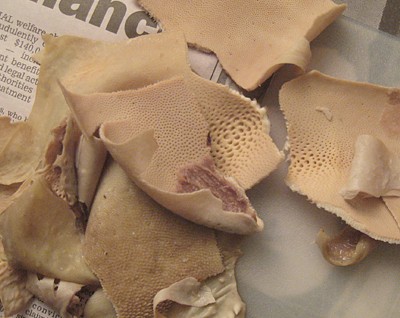In a recent New Yorker (yes, the Mulcher refers to them constantly – it’s like the Mulcher is their bitch; and you know what – referring to The Monthly doesn’t do the business). Oh yes, anyway in the NYer they had an article about these hairy ex-surfer dudes who have opened a cultish restaurant in LA called Animal. In a city of fashion-oppressed calorie-counters (the killer Steve Martin joke in LA Story – “I’ll have a half double decaf with a half caf. With a twist of lemon.”) Animal chefs Jon Shook and Vinny Dotolo – even their names sound the way they look: shaggy – make “gnarly big plates of food where each dish has three thousand calories,” as you can see in the swell New Yorker video above.
Meat is curious and problematicised. We had dinner for a friend on the weekend – along with a fellow guest she does not eat meat. She’s pescatarian, the other a vegetarian, but not vegan, for which the cook was grateful. Fish for everyone and an omelette for her. Everyone can agree that eating meat is natural, animals eat animals – even the Dalai Lama eats meat. Serve him veal if you like.
But apart from spiritual transcendence and evolved consciousness, Peter Singer and his tribe (lately, J. S. Foer) connect the dots between meat eating and the industrial context of “animal suffering and environmental degradation.” Women seem to lean that way. My guess (unresearched) is that women, indisputably more health-conscious than men, have also been more influenced by years of media about ‘the health benefits of reduced meat intake’ – the kind of phrase that smooths a patina of rationality over primal squeamishness (perhaps a conflict between our cavepeople past and the project of civilisation) about actual, raw flesh and blood, whether neutralised and hygenically rendered in gladwrapped styrofoam packs or not. In the old days of course, say pre ’60s – these weren’t obvious considerations: we slaughtered the infrequent chook in the backyard, and slabd of meat wasn’t an everyday option for most.
By the way, this meandering doesn’t go anywhere, only that one thinks about food quite a lot. It’s interesting in all kind of ways – for instance, food can be a visual feast. I regard offal as a good thing, because, if we’re dealing with an animal sacrifice, then we should regard all of that animal as a resource and all of it to be treated with respect. Besides, offal has great textural fascinations. Here are views of last night’s dinner (I wasn’t the cook). Some may find these gross or grotesque – but they refresh that dusty old proverb, Waste not, want not:











Crikey is committed to hosting lively discussions. Help us keep the conversation useful, interesting and welcoming. We aim to publish comments quickly in the interest of promoting robust conversation, but we’re a small team and we deploy filters to protect against legal risk. Occasionally your comment may be held up while we review, but we’re working as fast as we can to keep the conversation rolling.
The Crikey comment section is members-only content. Please subscribe to leave a comment.
The Crikey comment section is members-only content. Please login to leave a comment.